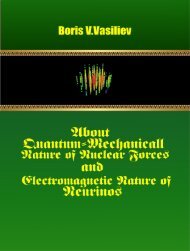VbvAstE-001
Book Boris V. Vasiliev Astrophysics
Book Boris V. Vasiliev
Astrophysics
Create successful ePaper yourself
Turn your PDF publications into a flip-book with our unique Google optimized e-Paper software.
6.3 The mass-temperature and mass-luminosity<br />
relations<br />
Taking into account Eqs.(4.18), (2.22) and (4.8) one can obtain the relation between<br />
surface temperature and the radius of a star<br />
or accounting for (6.16)<br />
T 0 ∼ R 7/8<br />
0 , (6.19)<br />
T 0 ∼ M 7/12 (6.20)<br />
The dependence of the temperature on the star surface over the star mass of close<br />
binary stars [11] is shown in Fig.(6.2). Here the temperatures of stars are normalized<br />
to the sunny surface temperature (5875 C), the stars masses are normalized to the mass<br />
of the Sum. The data are shown on double logarithmic scale. The solid line shows<br />
the result of fitting of measurement data (T 0 ∼ M 0.59 ). The theoretical dependence<br />
T 0 ∼ M 7/12 (Eq.6.20) is shown by dotted line.<br />
If parameters of the star are expressed through corresponding solar values τ ≡ T 0<br />
T ⊙<br />
and µ ≡ M<br />
M ⊙<br />
, that Eq.(6.20) can be rewritten as<br />
τ<br />
= 1. (6.21)<br />
µ<br />
7/12<br />
τ<br />
Numerical values of relations for close binary stars [11] are shown in the<br />
µ 7/12<br />
Table(6.2).<br />
The analysis of these data leads to few conclusions. The averaging over all tabulated<br />
stars gives<br />
< τ >= 1.007 ± 0.07. (6.22)<br />
µ<br />
7/12<br />
and we can conclude that the variability of measured data of surface temperatures and<br />
stellar masses has statistical character. Secondly, Eq.(6.21) is valid for all hot stars<br />
(exactly for all stars which are gathered in Tab.(6.2)).<br />
ρ<br />
The problem with the averaging of<br />
looks different. There are a few of giants<br />
µ 2/3 ρ<br />
and super-giants in this Table. The values of ratio are more than 2 for them. It<br />
µ 2/3<br />
seems that, if to exclude these stars from consideration, the averaging over stars of the<br />
main sequence gives value close to 1. Evidently, it needs in more detail consideration.<br />
The luminosity of a star<br />
L 0 ∼ R 2 0T 4 0. (6.23)<br />
at taking into account (Eq.6.16) and (Eq.6.20) can be expressed as<br />
L 0 ∼ M 11/3 ∼ M 3.67 (6.24)<br />
This dependence is shown in Fig.(6.3) It can be seen that all calculated interdependencies<br />
R(M),T(M) and L(M) show a good qualitative agreement with the measuring<br />
data. At that it is important, that the quantitative explanation of mass-luminosity<br />
dependence discovered at the beginning of 20th century is obtained.<br />
49













